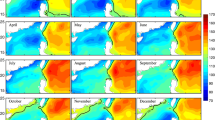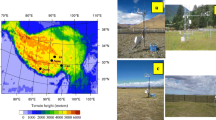Abstract
The method proposed by Stammer (1998) is modified using eddy statistics from altimeter observation to obtain more realistic eddy diffusivity (K) for the North Pacific. Compared with original estimates, the modified K has remarkably reduced values in the Kuroshio Extension (KE) and North Equatorial Counter Current (NECC) regions, but slightly enhanced values in the Subtropical Counter Current (STCC) region. In strong eastward flow areas like the KE and NECC, owing to a large difference between mean flow velocity and propagation velocity of mesoscale eddies, tracers inside the mesoscale eddies are transported outside rapidly by advection, and mixing length L is hence strongly suppressed. The low eddy probability (P) is also responsible for the reduced K in the NECC area. In the STCC region, however, L is mildly suppressed and P is very high, so K there is enhanced. The zonally-averaged K has two peaks with comparable magnitudes, in the latitude bands of the STCC and KE. In the core of KE, because of the reduced values of P and L, the zonally-averaged K is a minimum. Zonally-integrated eddy heat transport in the KE band, calculated based on the modified K, is much closer to the results of previous independent research, indicating the robustness of our modified K. The map of modified K provides useful informationfor modeling studies in the North Pacific.
Similar content being viewed by others
References
Bryden H L, Heath R A. 1985. Energetic eddies at the northern edge of the Antarctic Circumpolar Current. Prog. Oceanogr., 14: 65–87.
Bryden H L, Brady E C. 1989. Eddy momentum and heatfluxes and their effects on the circulation of the equatorial Pacific Ocean. J. Mar. Res., 47: 55–79.
Bryan K, Dukowicz J K, Smith R D. 1999. On the mixing coefficient in the parameterization of bolus velocity. J. Phys. Oceanogr., 29: 2 442–2 456.
Chaigneau S, Gizolme A, Grados C. 2008. Mesoscale eddies off Peru in altimeter records: identification algorithms and eddy spatio-temporal patterns. Progr. Oceanogr., 79: 106–119.
Chen G, Gan J, Xie Q, Chu X, Wang D, Hou Y. 2012. Eddy heat and salt transports in the South China Sea and their seasonal modulations. J. Geophys. Res., 117: C05021, http://dx.doi.org/10.1029/2011JC007724.
Chelton D B, de Szoeke R A, Schlax M G, El Naggar K, Siwertz N. 1998. Geographical variability of the first-baroclinic Rossby radius of deformation. J. Phys. Oceanogr., 28: 433–460.
Chelton D B, Schlax M G, Samelson R M, de Szoeke R A. 2007. Global observations of westward energy propagation in theocean: Rossby waves or nonlinear eddies? Geophys. Res. Lett., 34:L15, 606.
Chelton D B, Schlax M G, Samelson R M. 2011. Global observations of nonlinear mesoscale eddies. Prog r. Oceanogr., 91(2): 97–166.
Davis R. 1987. Modelling eddy transport of passive tracers. J. Mar. Res., 45: 635–666.
Davis R. 1991. Observing the general circulation with floats. Deep Sea Res., 38(Suppl.1): S531–S571.
Ducet N, Le Traon P Y, Reverdin G. 2000. Global high-resolution mapping of ocean circulation from TOPEX/Poseidon and ERS-1 and -2. J. Geophys. Res., 105: 19 477–19 498.
Eden C. 2006. Thickness diffusivity in the Southern Ocean. Geophys. Res. Lett., 33: L11606, http://dx.doi.org/10.1029/2006GL026157.
Eden C, Greatbatch R J, Willebrand J. 2007a. A diagnosis of thickness fluxes in an eddy-resolving model. J. Phys. Oceanogr., 37: 727–742.
Eden C, Greatbatch R J, Olbers D. 2007b. Interpreting eddy fluxes. J. Phys. Oceanogr., 37: 1 282–1 296.
England M H, Rahmstorf S. 1998. Sensitivity of ventilationrates and radiocarbon uptake to subgrid-scale mixing in ocean models. J. Phys. Oceanogr., 29: 2 802–2 827.
Ferreira D, Marshall J, Heimbach P. 2005. Estimating eddy stresses by fitting dynamics to observations using a residual-mean ocean circulation model and its adjoint. J. Phys. Oceanogr., 35: 1 891–1 910.
Ferrari R, Nikurashin M. 2010. Suppression of eddy diffusivity across jets in the Southern Ocean. J. Phys. Ocea n ogr., 40: 1 501–1 519.
Holloway G. 1986. Estimation of oceanic eddy transports from satellite altimetry. Nature, 323: 243–244.
Isern-Fontanet J, García-Ladona E, Font J. 2003. Identificationof marine eddies from altimetry. J. Atmos. Oceanic Technol., 20: 772–778.
Jayne S R, Marotzke J. 2002. The oceanic eddy heat transport. J. Phys. Oceanogr., 32: 3 328–3 345.
Marshall J, Shutts G. 1981. A note on rotational and diver-gent eddy fluxes. J. Phys. Oceanogr., 11: 1 677–1 680.
Marshall J, Shuckburgh H, Hill C. 2006. Estimates and implications of surface eddy diffusivity in the Southern Ocean derived from tracer transport. J. Phys. Oceanogr., 36: 1 806–1 821.
Maximenko N, Niiler P, Rio M, Melnichenko O, Centurioni L, Chambers D, Zlotnicki V, Galperin B. 2009. Mean dynamic topography of the ocean derived from satellite and drifting buoy data using three different techniques. J. Atmos. Oceanic Tech., 26(9): 1 910–1 919.
Nakamura N. 1996. Two-dimensional mixing, edgeformation, and permeability diagnosed in area coordinates. J. Atmos. Sci., 53: 1 524–1 537.
Prandtl L. 1925. Bericht über untersuchungen zur ausgebildeten turbulenz. Z. Angew. Math. Mech., 5: 136–139. (in German)
Qiu B, Chen S. 2005. Eddy-induced heat transport in the Subtropical North Pacicfic from Argo, TMI, and Altimetry measurements. J. Phys. Oceanogr., 35: 458–473.
Rossby T. 1987. On the energetics of the Gulf Stream at 73W. J. Mar. Res., 45: 59–82.
Roemmich D, Gilson J, 2001. Eddy transport of heat and thermocline waters in the North Pacific: A key to interannual/decadal climate variability?. J. Phys. Oceanogr., 31: 675–687.
Stammer D. 1998. On eddy characteristics, eddy transports, and mean flow properties. J. Phys. Oceanogr., 28: 727–739.
Stammer D, Wunsch C, Ueyoshi K. 2006. Temporal changes in ocean eddy transports, J. Phys. Oceanogr., 36: 543–550.
Taylor G 1921. Diffusion by continuous movements. Proc. Roy. Soc. A, 64: 476–490.
Volkov D L, Larnicol G, Dorandeu J. 2007. Improving the quality of satellite altimetry data over continental shelves. J. Geophys. Res., 112: C06020, http://dx.doi.org/10.1029/2006JC003765.
Wunsch C. 1999. Where do ocean eddy heat fluxes matter?. J. Geophys. Res., 104: 13 235–13 249.
Yim B Y, Noh Y, You S H, Yoon J H, Qiu B, Chen S. 2010. The vertical structure of eddy heat transport simulated by an eddy-resolving OGCM. J. Phys. Oceanogr., 40: 340–353.
Zhang Z, Zhong Y, Tian J, Yang Q, Zhao W. Estimation of eddy heat transport in the global ocean from Argo data. Acta Oceanol. Sin., in press.
Zhurbas V, Oh S I. 2004. Drifter-derived maps of lateral diffusivity in the Pacific and Atlantic Oceans in relation to surface circulation patterns. J. Geophys. Res., 109: C05015, http://dx.doi.org/10.1029/2003JC002241.
Author information
Authors and Affiliations
Corresponding author
Additional information
Supported by the Major Program of the National Natural Science Foundation of China (No. 40890153) and the National High Technology Research and Development Program of China (863 Program) (No. 2008AA09A402)
Rights and permissions
About this article
Cite this article
Zhang, Z., Li, Y. & Tian, J. A modified method to estimate eddy diffusivity in the North Pacific using altimeter eddy statistics. Chin. J. Ocean. Limnol. 31, 925–933 (2013). https://doi.org/10.1007/s00343-013-2214-2
Received:
Accepted:
Published:
Issue Date:
DOI: https://doi.org/10.1007/s00343-013-2214-2




